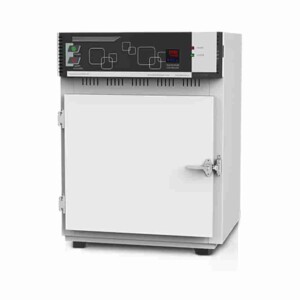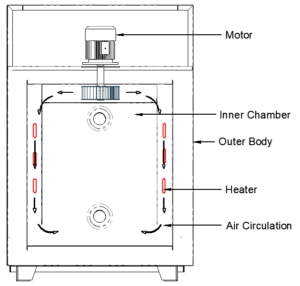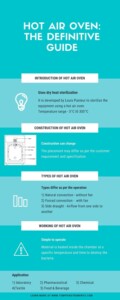HOT AIR OVEN: THE DEFINITIVE GUIDE

Hot air oven
Hot air ovens are laboratory and scientific equipment which uses dry heat (hot air mixture) for sterilization of laboratory equipment.
The dry heat sterilization process is developed by Louis Pasteur to sterilize the equipment using the hot air ovens. Dry heat sterilization is the heating process in which the material which is placed inside the oven has the characteristics which will not melt, catch fire or changes its form while heating at high temperature.
Our hot air oven runs at extremely high temperature for several hours to destroy the bacteria. The general temperature range required for operation varies from 5°C to 450°C as per the customer need.
Most of the pharmaceutical industries use these hot air ovens to sterilize laboratory instruments and materials because they are simple to operate. The lab ovens also offered a quick dying process. Further more details are provided so read more to get a complete understanding.

Laboratory oven construction
- Cabinet – Our hot air ovens are uses for triple-walled construction. The cabinets are made using stainless steel material. A single door is provided which is fitted on the heavy hinges and provided the required gasket to reduce the leakage.
- Insulation – The gap between the inner chamber and outer cabinet is filled with 3″ thick glass wool insulation. It provides insulation to the oven so that the heat is lost during operation.
- Tubular air heaters – The heaters are used to generate the heat inside the inner chamber. The heaters are placed on both sides of the inner chamber.
- Blower –The blower is used to recirculate the hot air mixture inside the chamber to achieve a uniform temperature profile inside the chamber. In a natural convection oven, the blower is not required. The desire temperature profile is achieved naturally.
- Temperature sensor – The temperature sensor senses the temperature the displays it on the screen.
- Trays and slots – The specially designed stainless steel rod trays are provided to place the material for heating. The number of trays and slots required can be changed as per the customer requirement.
- PID temperature controller – The microprocessor-based autotune PID controller is used to maintaining the desired temperature ranges during the operation.
- Main switch – It helps the turn on and turn off the hot air oven.
- Safety thermostat – It helps to protect your oven from temperature overshoot.

Laboratory hot air oven working
Dry heat sterilization is performed by conduction. First, the door is open and the object is placed on the tray. The trays having the object, placed inside the chamber on the slots. The door is closed and the switch turns on. The hot air oven is then set to desired temperature and time that is required for the sterilization.
As the hot air mixture start to generate and the temperature starts to increase, the heat is first consumed by the outer surface of the object and then it gradually moves towards the core, layer by layer. The whole object will uniformly achieve the desired temperature required for the sterilization. After running for the specified time the oven gets turned off. Once the process is done then the door is opened and the tray holder is taken out. The object is allowed to cool for some time and then use for further application.
Types of hot air oven
- Natural convection oven – In natural convection oven the temperature is achieved naturally (gravity convection) without the use of a motorized blower. The temperature distribution is not uniform in this type of oven.
- Forced convection oven – In a forced convection oven the motorized blower is used to achieve the desire working temperature. The blower is fitted to the motor. The temperature achieved is fast and uniform in this type of oven as compared to the natural type.
- Side draught ovens – These type of ovens produces airflow from one side to the other. This type of lab oven produces fast heat-up speed and less recovery time with minimal maintenance.
Optional features
- Data logger
- Data scanner complete with sensor
- CFR 21 part 11 compliance software for data logger/scanner
- Safety digital temperature controller
- Timer
Advantages
- Water is not needed for sterilization like an autoclave.
- The pressure build is less which is safer while operating.
- More effective to work and smaller in size.
- Operation is simple
- Price is low
Disadvantages
- Not useful for some living organisms due to the dry heat.
- Most materials are not suitable like rubber items, plastic material due to the low melting point.
Application
- Use for dry sterilization in laboratories, pharmaceutical labs, microbiology labs etc.
- Chemical industries
- Food and beverages
- Pharmaceutical industries
TEMPO Instruments is a leader in the heating (oven) industry and know for its value. Wonder how to select the perfect oven that suits your requirement, contact us or click the button below to consult with our experts.
